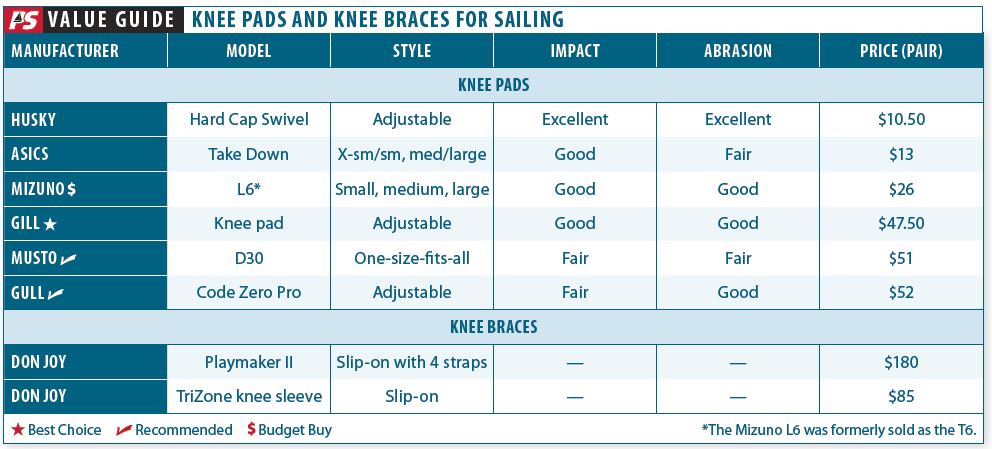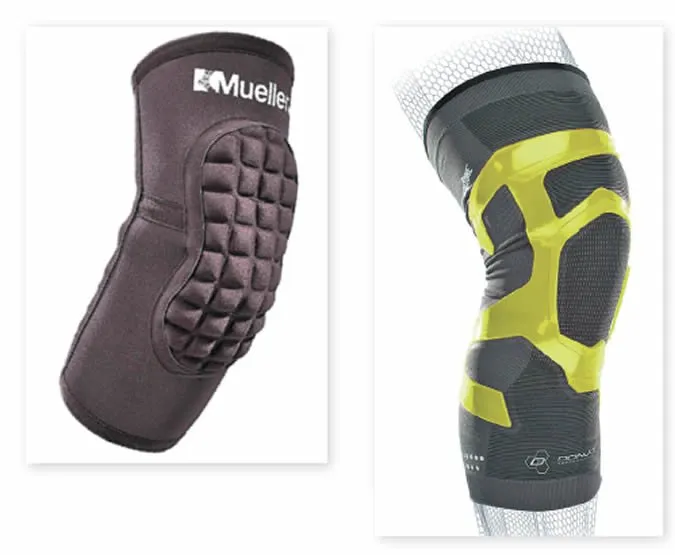Battered sailors make good test subjects, especially when we are talking about gear to preserve our joints and appendages. That is why we sent technical editor Drew Frye and his surgically repaired knee out into the world of orthopedic accessories for sailors.
Before any whipper-snappers among our readers scoff and flip the page, keep in mind that some of the most active racers on the planet use this same gear for protection. They recognize that over the years athletes accumulate micro injuries (yes, even cruising is an athletic activity). The sooner you start to limit the toll, the better your chances of sailing well beyond your 70s and 80s.
What We Tested
We looked at a range of knee (and elbow) equipment designed to protect the joint from impact and twisting that might cause harm. Our selection included equipment from Gul, Gill, and Musto who cater to racing sailors, as well as manufacturers who work outside the sailing arena such as Mizuno (volleyball), and Husky (construction). We also looked at knee braces from Don Joy, a company that designs braces especially for athletes.

Photos by Drew Frye
How We Tested
Frye put the various products through a range of activities on board to assess their performance when carrying out the usual onboard tasks, including maintenance chores. He also tested their resistance to impact and abrasion. Because the performance of these products can vary by fit, he enlisted the help of some equally broken-down sailors to offer their assessment. Approach buying this gear like buying shoes; give them a good trial for fit.
Observations
Fryes knee problem are the accumulation of incidents beginning with a shattered knee cap suffered in a college bike race and, more recently, a torn meniscus sustained helping his daughter move into college. He also spent many years in a day job that often required sustained kneeling while performing inspection tasks. Here are some of his observations on managing these injuries.
Pad type. In his beach cat sailing days, he often wore volleyball pads. While these work on a slick gym floor, they slid out of position on the boat. He soon switched to wrestling knee pads and sailing-specific pads, which worked much better.
Boat Yoga. Warm-up a bit first. Pad hard spots with folded-up towels. However, knee and elbow pads can help. Drew has suffered serious irritation to the elbow bursa, requiring draining, from actions as simple as leaning on one side in a tight space or levering himself up through a hatch.
Decks and Gravel. Often the most demanding activities for a boater take place in the boat yard. The minutes or even hours spent cleaning decks, driving screws, trimming caulk, or painting the bottom involve hard surfaces and contortions. For this use, soft pads don’t provided the support or load distribution of a hard shell knee pad, and your kneecap is still being pushed around. Hard cap pads, on the other hand, redistribute the force over the entire knee and are more comfortable than a feather pillow.
Twisting. If you’ve had serious knee surgery you’ve probably been introduced to more advanced knee braces, but perhaps not. Many doctors feel that the continuous use of a brace for injuries that did not dramatically reduce knee stability (ACL tear etc.) can lead to dependency and weakening of the knee structure. Regarding daily wear, this is almost certainly true, but a little extra protection during athletic activities is prudent.
Unfortunately, the equipment they sell at the sporting goods store is close to useless in terms of providing actual functional support. Instead, shop at one of several on-line providers of braces for serious athletes and rehab facilities.
Expect to pay real money for these; $150-$400 is typical for a good 4-strap brace with range-of-motion control. These will also require some custom fitting, which in many cases you can do yourself (bend the stays to match the curve of your thigh).
Additionally, arthritis braces can be adjusted to transfer weight either inside or outside, for those who suffer from meniscus deterioration; you will need the help of a physical therapist to select and fit one of these.
ROM (range of motion) stops can prevent damaging bottoming out of joints that don’t like to bend that far. Braces with this feature are always adjustable, from just a slight bend to full range of motion.
Finally, keep a square of interlocking foam flooring in the cockpit, stashed under a cushion for kneeling while you fix whatever needs to be fixed.
Knee Pads
Like shoes, if knee pads don’t fit both the size and shape of your knee, they will not perform. You’re going to have to try them on. If you also wear a knee brace, put that on first-occasionally a different size is required for each knee.
Husky Hard Cap
The least expensive of the test group, they are not the least expensive hardware store pads. Weve used these through a decade of boat maintenance and thousands of hours of industrial on-the-knees inspection work. They are light, cool with the open back design, very protective of the knees, and very comfortable. They arent for sailing or even extended walking around. These are work pads.
Bottom line: Keep a pair in the tool box for extended on-the-knees work and bottom maintenance.
Gill Knee Pads
Adjustable and very hard wearing, Frye and the other testers voted these most likely to stay in place all day. They can be a little bulky under foul weather gear. Although we didnt spend time kneeling on the gravel to check durability, the fabric looks tough, and some of the pads we examined had been sailing hard for many years without appreciable wear.
Bottom line: These are our all-around Best Choice.
Gull
Adjustable and hard wearing, these knee pads were a little more difficult to keep in place, although some testers loved them. We found them to be a comfortable fit under foul weather gear.
Bottom line: Meeting all the requirements of sailors, these pads are recommended.
Musto D-30
A one-size-fits-all design, the Musto pad is thinner than other products. Many racing sailors regard this as the most practical pad for use under foul weather gear. Relatively long, it generally stays in place, although it slid down on slender testers. They are less resistant to abrasion than others. Wear them under something or lay some duct tape across them when crawling in the gravel.
Bottom line: Recommended for sailing and light maintenance.
Asics Low Profile
These knee pads barely met the minimum requirements. The construction is hardly rugged, and the pads didnt stay in place. They were also less comfortable than otherpads.
Bottom line: Some sailors may like this gear. Our testers did not.
Mizuno L6
For sailing and in-boat maintenance, Mizunos versatile L6 pad was our budget-priced favorite. Designed for volleyball, they feature a medium thickness, afford a great range of motion, and provide good padding. On our testers knees at least, they stayed in place well, even when worn with shorts.
Bottom line: Affordable with good fit, these are our Budget Buy.
Knee Braces
You don’t just go out and buy a knee brace without some professional guidance-either from a doctor or physical therapist. Your own best choice depends on your preferences and injury history.
The following products are presented only as examples that Frye knows from personal experience to wear well; your physical therapist should be able to help fine-tune a selection. If you have a great knee brace, please let us know.
Don Joy PlayMaker II
Frye has worn this brace and its predecessor design for nearly 30 years. It is economical, rugged, and offers compression plus protection from slight twists and over-flexing. It works skiing, skating, surfing, hiking over rough terrain, and sailing. While it would be a stretch to say any supportive brace is comfortable when strapped down, you can wear it all day and will never cause blisters.
Bottom line: If youve had surgery or needed it, this is a smart investment.
Don Joy Trizone Sleeve
Simulating protective taping, it offers more comfort, less protection, and a lower price. Frye has worn it a few months and it helped.
Bottom line: This is a good starter brace, providing support similar to an Ace bandage, but easier to use.
Conclusions
We like hard-cap knee pads for boat yard days, Spinlock and Gul adjustable open-back pads for fast, summer sailing, and thin slip-on pads like the Musto D-30 for under foul weather gear and boat yoga, where a slim design is required for fit and to reduce snagging. Finally, we like advanced knee braces for aging or injured knees, as a preventative against wear, tear and re-injury. Yup, that’s three sets of pads and a pricey brace, but only one set of knees, so its worth it, in our view.
Elbows deserve protection when leaning on them in the bowels of the boat and some people like them while sailing. Feet, knees and hips can be overstressed, particularly by long days in deck shoes with poor support.




































The choices to make are as clear as a muddy bottom , if you are going to bother writing the piece then make your recamendations clear with links to the products.
This article needs some updating, please. There is a picture of a Mueller pad that is never discussed and a picture of another pad that is un-named. I am presuming that Gull is referring to Gul (which I can’t find sold in the US). There are also no links to any of the products tested.
I’d add Home Depot Husky kneepads to the list of good investments. I have Musto, Gill, and other name brands in my inventory, but find the HDs are easiest to don and stay in place with thick Velcro.
I can’t believe you passed over the Spinlock Knee pads. I am an older (60+) J80 sailor and cruiser and I swear by them. They have different sizes so you get a good fit and a Right and Left so that the pad is formed properly around the knees and won’t slip from side to slide up or down. The wide stretch material breathes well, dries quickly and fit is adjusted by velcro straps top and bottom. The knee cap material is a very durable cloth type that doesn’t slip and have lasted 3 seasons of racing with no noticeable abrasion. They fit well my foulies/salopette or wind pants and are comfortable for those 6 hour regattas.
I hope you can made an amendment to your article because these are tested tough and a top quality product that have seen plenty of abuse on dock and deck.